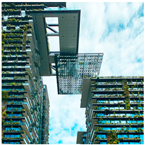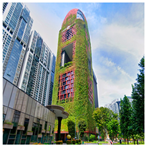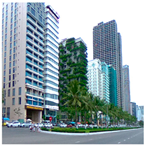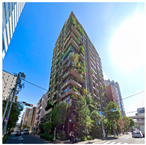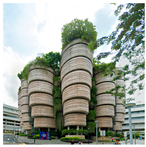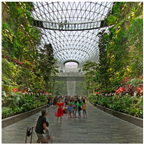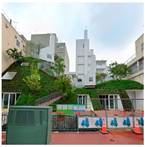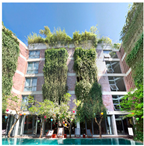Abstract
Over the past decade, biophilic architecture has been widely developed across the Asia–Pacific region. However, there is a notable lack of research based on online public reviews focusing on mid- to high-rise biophilic buildings, especially quantitative studies combining traditional architectural design features. This study aims to fill this gap by analyzing the typical floor plans and online public reviews of nine renowned biophilic buildings in the Asia–Pacific region. Using space syntax and natural language processing tools, the design features of typical floor plans and public feedback will be analyzed separately, and their correlation will be evaluated. Additionally, the content of negative and low-score reviews will be categorized to identify issues in current biophilic building designs. The findings suggest that biophilic design can stimulate widespread public discussion, with large direct blue–green elements receiving overwhelming attention. However, biophilic elements can also lead to negative sentiments due to factors like humidity, high temperatures, mold, and insects. This study provides insights and design recommendations for future biophilic buildings, demonstrating the value of biophilic design in public reviews and emphasizing the need to balance these factors to enhance public satisfaction and acceptance.
1. Introduction
Humans have a deep-rooted desire to live in harmony with nature, often referred to as “Poetically Man Dwells” [1]. This understanding is the foundation of “biophilic architecture” [2]. In recent years, advancements in technology and craftsmanship have led to a surge in biophilic buildings worldwide, aiming to address environmental challenges [3], achieve sustainability goals [4,5], and bridge the gap between urban culture and nature [6]. In urban environments, nature not only alleviates pollution and urban heat island effects but also addresses social issues such as mental health and crime [7,8,9]. Existing studies indicate that direct exposure to natural elements significantly benefits human attention restoration, emotional stress improvement, and cognitive function [10,11,12]. Moreover, these biophilic buildings often attract widespread attention from public media due to their striking visual designs and receive positive feedback regarding commercial space experiences [3,13,14].
Previous research on biophilic architecture largely consists of case studies [15,16,17,18,19]. Watchman et al. [15] evaluated biophilic characteristics in school buildings using architectural parameters in three elementary schools in Canada. Yaseen and Mustafa [16] explored quantitative assessment methods for biophilic design in nine school buildings using spatial syntax, validated by surveys of local teachers and students. Watchman et al. [17] studied design vocabulary and development patterns of biophilic school buildings in cold, humid regions based on six cases. Zhong et al. [18] analyzed “natural” design in three-dimensional green spaces using a biophilic design framework based on semi-structured interviews, design document analysis, and field observations in two building practices. DeLauer et al. [19] investigated the impact of natural environments and biophilic design on residential undergraduates through surveys at a rural campus in the USA. Nanu et al. [13] used semantic analysis of customer reviews to study the impact of biophilic design in hotel lobbies on customer choices.
However, most of previous studies’ case selections are not focused on typical biophilic architectures or buildings using “biophilia” as a selling point [15,16,17,18,19]. Moreover, spatial experience perception relies on spatial psychological processes [20,21], influenced by both the readability of the objective spatial environment and individual subjective differences [22]. Spatial readability is primarily affected by two-dimensional layout characteristics and three-dimensional visual markers [21]. Current research lacks exploration of the relationship between classic architectural concepts such as spatial depth and broad public (general user) evaluations. Additionally, there is a notable lack of studies on typical floors in mid-high-rise and high-rise buildings. Lower-height buildings or the ground floor of high-rise buildings can integrate with the site through landscape design, achieving a high biophilic level and potentially becoming part of the natural landscape. In contrast, biophilic experiences in mid-high-rise and high-rise buildings are mainly provided by the building’s internal spaces, less influenced by surrounding environments, making it easier to clarify the impact of biophilic architectural design on spatial experiences.
Therefore, this study aims to fill the current research gap in biophilic architecture by examining subjective user evaluations and objective spatial design characteristics. Based on Google Maps reviews of nine representative high-level biophilic projects in the Asia–Pacific region over the past decade, this study explores the relationship between the design characteristics of typical floors and public online reviews. The findings reveal that all buildings received highly positive reviews related to architectural and spatial environments, with a high proportion of mentions of “biophilic” experience. Quantitative analysis of these reviews and spatial design characteristics showed that a larger amount of natural elements led to higher mention frequencies of “biophilic”; negative sentiment levels were correlated with visual integration and the visual clustering coefficient. However, no significant correlations were found between other design features such as the biophilic element ratio, spatial connectivity, and the accessibility of biophilic elements and reviews. Additionally, it was found that comments mentioning biophilic elements generally had slightly lower positive sentiment, slightly higher negative sentiment, and a higher proportion of neutral sentiment compared to overall space design evaluations. Nonetheless, the overall sentiment score for comments mentioning biophilic elements was more positive. This indicates that the public may have higher expectations for biophilic elements, leading to more dissatisfaction and criticism of specific details, but overall, they still recognize the positive impact of this design concept. Negative comments mainly focused on hygiene issues caused by moisture, insects, dead branches, noise problems, and unmet expectations for close contact with biophilic elements. Some also believe artificial nature is “absurd”, preferring the external view over living inside.
It should be noted that this study analyzed only nine cases (biophilic design concepts in mid- to high-rise buildings are costly, thus limiting the sample size), which may significantly limit the findings and conclusions. However, these results can still provide valuable references for designing more effective and comfortable biophilic buildings in the future. Architects, urban planners, developers, policymakers, and environmental psychologists can leverage the insights from this study to advocate for and implement biophilic principles in architectural development projects. By using better biophilic design, they can create environments that enhance human well-being and satisfaction, ultimately contributing to more sustainable and enjoyable building spaces.
The subsequent sections of this paper present the methodology and materials, results, discussion, conclusions, and reflections of the study, providing a detailed examination of the methods used, the findings obtained, and their implications for the field of biophilic design, along with ideas for future research.
2. Materials and Methods
2.1. Research Process
Figure 1 presents the flow of research process.
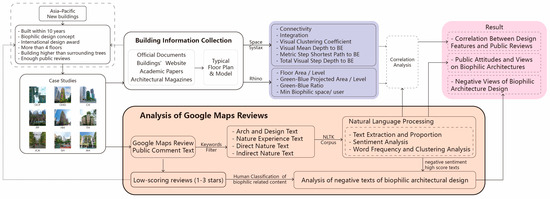
Figure 1.
Flow chart of research process.
Given the complexity and integrative nature of modern biophilic architecture, the definition and classification of biophilic buildings remain ambiguous or contentious [3]. Many studies are dedicated to the analysis of concepts and theoretical frameworks [23,24]. Stephen and Calabrese [25] proposed a three-category overview of biophilic architectural design from an experiential perspective: direct exposure of natural elements in the space, such as light, water, and plants; indirect contact through the symbolization or materialization of natural elements, such as wood and nature-themed artworks; and simulation of local culture and sense of place. However, the third category has a strong relationship with individual experiences and is hard to quantify. Therefore, this study focuses on the quantifiable analysis and discussion of the first two categories of biophilic design.
To quantitatively assess the biophilic design of building spaces using a consistent standard, this study focuses on the easily quantifiable, directly exposed natural elements in the objective spatial analysis phase. A traditional architectural and spatial analysis tool, Depthmap+ Beta 1.0 [26], was used to analyze the design characteristics of typical floors. Using the NLTK corpus [27], researchers then conducted natural language processing on public comments from Google Maps. Sentences related to building evaluation and spatial design were filtered, and comments mentioning direct and indirect natural elements were classified. These text groups underwent sentiment analysis, text clustering, word frequency analysis, and negative content semantic analysis. Finally, the correlation between the analyzed results of public reviews and the objective design characteristics of typical floors was examined, discussing the strengths and weaknesses of biophilic architectural design. Detailed technical methods can be found in Section 2.3.
2.2. Case Selection
Given the study’s objective to analyze public reviews of biophilic architecture and fill the current research gap in quantitative analysis based on typical floor plans, while minimizing the influence of surrounding landscapes, it was essential to define the criteria for selecting representative cases. In this study, “representative” was determined by “famous”, “mid-high-rise or high-rise”, and “notable buildings designed with biophilic concepts”. “Famous” denotes designs by globally renowned firms and those awarded international accolades (see specifics in Table 1). “Mid-high-rise or high-rise” buildings are defined as exceeding 5 floors and having typical plans higher than surrounding trees. “Notable buildings designed with biophilic concepts” refers to projects explicitly identified in official statements or recognized by architectural publications as biophilic (see details in Table 1).

Table 1.
Case study selection of biophilic buildings.
This study finally selected 9 high-rise buildings from the Asia–Pacific region over the past decade as cases (Table 1). Careful consideration balanced project locations and design teams to avoid overly similar projects, while ensuring a sufficient number of Google Maps reviews (at least 50 useful reviews). These 9 buildings, showcasing diverse architectural styles, originate from Australia, Singapore, Vietnam, and Japan—representing key countries in the Asia–Pacific region. It is noteworthy that Singapore contributes a significant proportion (3/12) due to its proactive efforts in biophilic architecture under urban strategies like “Gardens in the City” [46] and “Biophilic Urbanism” [47]. The absence of Chinese projects is due to restrictions on accessing homogeneous public review data from Google Maps within mainland China [48].
2.3. Technical Evaluative Methods
2.3.1. Methods of Quantitative Analysis of Objective Biophilic Spatial Design Characteristics
The most notable feature of biophilic architecture is the incorporation of natural elements, yet there are currently few tools available to analyze and quantify their spatial characteristics. Spatial syntax tools, often used in studies of Public Urban Green Spaces (PUGSs), are employed to quantify and evaluate spatial accessibility [49,50]. Buildings with medium- or high-intensity development are comparable to small city blocks, and indoor walkability indices are frequently used in BIM-supported circulation studies [51]. Some have already applied spatial syntax tools to evaluate the natural characteristics of biophilic design in education buildings [16,52]. Therefore, this study will use spatial syntax tools to evaluate connectivity and spatial depth and to calculate the average accessibility and visibility of biophilic elements.
Using information from open sources such as the official websites of design firms and architectural magazines, simplified and redrawn typical floor plans and models for each building were created. The projected area of biophilic elements and the typical floor occupancy were calculated based on the floor plans by rhino 7.0. After that, the Depthmap+ Beta 1.0 tool [26] was used to conduct spatial syntax analysis [53]. The units, meanings, and calculation methods of design parameters and the space syntax index are detailed in Table 2.

Table 2.
Design parameters and index.
2.3.2. Quantitative Analysis Method of Subjective Public Comments on Biophilic Architecture and Design
Spatial experience is a complex and subjective perception process [20], heavily influenced by individual perspectives. Interpretations by architects and the viewpoints of the general public are equally valuable. Therefore, this study focuses on analyzing descriptions of architectural and spatial design shared by ordinary users during their visit experiences on Google Maps.
As of 28 December 2023, a total of 62,549 comments were collected from Google Maps for these nine case studies. It is noteworthy that Jewel Changi Airport garnered 53,694 reviews, significantly more than the other buildings, due to its function as a transportation hub. To balance data sources, only the most relevant 4000 comments of Jewel Changi Airport were extracted. All comments for the remaining eight buildings were included in the statistics, resulting in a total of 12,855 Google Maps reviews as the foundational textual data for public evaluation analysis. Additionally, visitor comments on Google Maps were primarily in English but also included Japanese, Korean, Chinese, Italian, French, and other languages. For consistency in subsequent text analysis, these comments were translated into English during extraction using the Google Chrome browser page translation feature.
To preprocess the text and extract statements related to architecture and spatial design, the authors initially manually reviewed 2500 comments. It was observed that many comments discussed staff behavior, food taste, and other irrelevant topics. Additionally, short sentences expressing only emotions such as “Great!” also needed to be excluded due to ambiguity regarding what was being praised. Based on this manual review, the authors curated a corpus of statements related to architecture and biophilic design, incorporating specific keywords (Table 3). Using Python scripts developed from this corpus, architecture- and design-related statements were filtered and extracted. After this initial filtering, the texts underwent a second round of manual screening to remove content solely related to room service, such as the quality of shampoo provided in rooms. Ultimately, 7949 texts were confirmed to be related to architecture and design, forming the foundational textual database for subsequent research.

Table 3.
Keywords for architecture- and design-related text selection.
Subsequently, the public comment sentences related to architecture and design were subjected to a series of natural language processing (NLP) procedures using Python. (1) Using the NLTK library (Natural Language Toolkit) [27], each text was analyzed for “negative”, “neutral”, “positive”, and “compound” sentiment tendencies [54,55]. (2) After excluding the NLTK’s English stopword list [56] and an additional domain-specific stopword list provided by the authors [57,58], word frequency analysis was performed. (3) K-means clustering was applied using the elbow method to group the summarized sentences [59,60,61], and TF-IDF was used to extract themes [62].
Using the same method, sentences related to biophilic experience were further extracted from these texts and classified into direct nature-related elements and indirect nature-related groups (Table 4). The sentiment and semantic analysis methods mentioned above were then applied to these sentences groups.

Table 4.
Keywords for biophilic experience related text selection.
Additionally, the mention rate of biophilic experiences in the architecture- and design-related texts for different cases was calculated, as well as the proportionate relationship of the two types of biophilic experience mentioned in each case. Furthermore, all texts related to biophilic experience that exhibited “negative” sentiment were extracted and manually categorized based on their semantics.
2.3.3. Method of Correlation Analysis between Subjective Evaluations and Objective Design Parameters
First, a Pearson correlation matrix analysis [63,64] was conducted for all parameters to measure the linear relationships between them. A value close to 1 or −1 indicates a strong positive or negative linear correlation, respectively [65]. Generally, an absolute correlation coefficient greater than 0.7 is considered indicative of a strong correlation [66].
3. Results
3.1. Results of the Quantitative Analysis of Objective Design Parameters in Biophilic Architecture
Table 5 shows the biophilic design parameter quantification results of the 9 cases.

Table 5.
Biophilic design parameter quantification results.
3.2. Results of Subjective Analysis of Google Maps Review Texts
3.2.1. Text Extraction and Proportion
First, a Python program was employed to filter out sentences related to “Architecture & Design”. From this subset, sentences specifically pertaining to “Biophilic Elements” were further extracted, and the nature experience mention rate was calculated. These sentences were then categorized into two groups based on their content: “Direct Nature Experience” and “Indirect Nature Experience”. The specific counts for each category are detailed in Table 6.

Table 6.
Number of related sentences for sentiment analysis.
Figure 2 illustrates the composition of comments related to biophilic experiences. Sentences related to direct nature experiences account for more than 65% in all cases, representing an overwhelming majority.

Figure 2.
Number of related sentences for sentiment analysis.
3.2.2. Sentiment Analysis Results
Figure 3 present the results of sentiment analysis, including negative, neutral, positive, and overall scores. In the legends, “-A” and “-B” represent “Architecture & Design related sentences” and “Biophilic Experiences related sentences” for the same project, respectively.
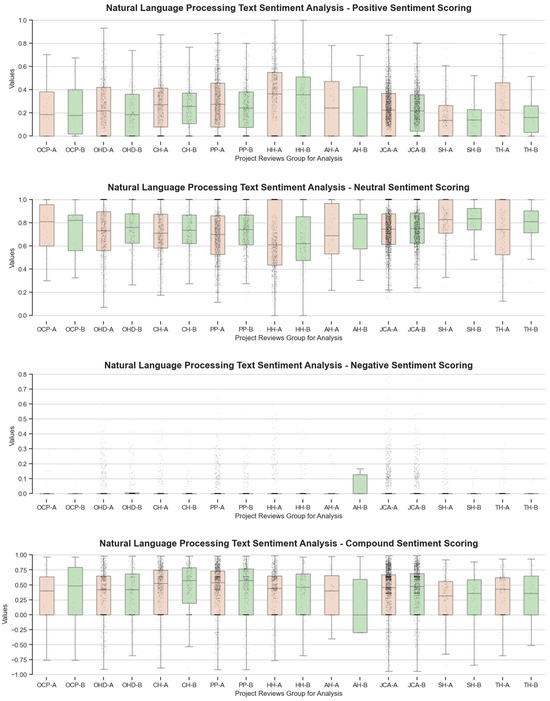
Figure 3.
Sentiment analysis results.
Overall sentiment analysis indicates that neutral sentiments are predominant, negative sentiments are relatively infrequent, and the overall scores are high, suggesting a very positive attitude towards these buildings. Compared to all comments on architecture and design, sentences mentioning biophilic experiences exhibit a higher degree of emotional expression and a more concentrated range of emotions. On average, these comments show slightly lower positive sentiments, slightly higher negative sentiments, and a higher proportion of neutral sentiments. Despite this, the overall sentiment score for comments mentioning biophilic elements is higher, indicating a more positive overall sentiment.
Further content analysis was conducted on 1044 negative sentiment texts related to architecture and design. From these, 520 statements were manually extracted, revealing clear complaints related to architectural space and biophilic design factors. Due to the small sample size and complex content, the reasons were manually classified into 15 main categories (Table 7).

Table 7.
Reasons of positive reviews.
3.2.3. Results of Word Frequency and Text Clustering Analysis
Table 8 presents the results of the grouped word frequency analysis, offering insights into the core themes discussed in these reviews. Stop words have been filtered out, and words with the same root have been consolidated.

Table 8.
Word frequency analysis result of each text group.
Figure 4 presents the clustering analysis results of architecture- and design-related texts from all cases, including scatter plot mapping, the number of texts in each cluster, and content summaries.

Figure 4.
Clustering analysis results of architecture- and design-related texts.
3.3. Correlation Analysis Results of Subjective Design Parameters and Objective Evaluations
Figure 5 presents the Pearson correlation coefficients for the 20 parameters in a matrix format. Parameters I to XI represent objective design parameters, while XII to XX represent subjective evaluation parameters. Cells with a correlation coefficient higher than 0.7 are highlighted in green. The analysis reveals that the greater the total green and blue projected area (I), the higher the frequency of biophilic experience mentions in architectural design evaluations (XVI), with a strong correlation coefficient as high as 0.80. Although the correlation coefficient between III and XVI also reached 0.71, it is difficult to determine a strong relationship between III and XVI due to the high correlation coefficient of 0.96 between I and III.
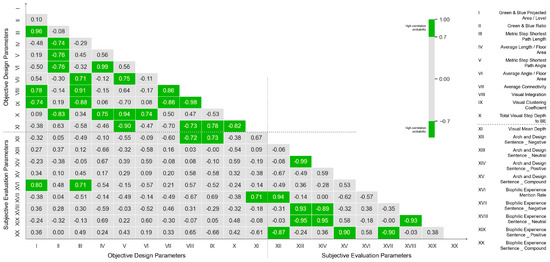
Figure 5.
Pearson correlation matrix.
Additionally, a negative correlation (−0.72) was found between the negative score of Arch and Design Sentences (XII) and Visual Integration (VIII), and a strong positive correlation (0.73) was found between Arch and Design Sentences (XII) and the Visual Clustering Coefficient (IX). The negative score of Biophilic Experience Sentences (XVII) also showed a strong positive correlation with Visual Mean Depth (XI). Other parameters, such as the Green and Blue Ratio, per capita area of standard floors, and the accessibility and visibility of biophilic elements, did not show significant correlations with public subjective evaluation scores.
3.4. Results of Manual Analysis of Low-Scoring Reviews on Google Map
Content containing biophilic design element keywords in low-rated (1–3 stars) Google Maps reviews was extracted to identify areas of public dissatisfaction. Due to the small dataset and the lack of concentration of semantically complex words, these 1749 statements could only be classified manually. Among the low-scoring review sentences, 89.42% expressed disappointment with typical public building space design aspects such as wayfinding, insufficient seating, and room size, without mentioning natural elements. Of the remaining comments, 23.08% noted that the landscaping and green plants did not meet expectations or that certain attractions were out of service; 13.74% mentioned that access to blue and green elements required additional payment or higher expenses. Additionally, 28.57% reported issues with poorly ventilated indoor spaces, describing them as humid, hot, dimly lit, and plagued by mold or bugs; 3.30% complained that fallen leaves affected their experience; and 6.59% felt that the water was unclean, uncomfortable, or noisy. Furthermore, 12.64% criticized artificial nature (landscaping) as being fake and not truly environmentally friendly, with some even using fake green plants; 15.38% felt that the buildings were just ordinary structures with added blue and green elements; and 9.34% believed that the buildings were more impressive from the outside than the inside.
4. Discussion
Table 6 shows that the mention rate of nature experience in architecture- and spatial-design-related comments ranges from a minimum of 12.12% to a maximum of 62.04%. This generally high mention rate indicates that the public unconsciously tends to care about biophilic elements and describe personal natural experiences in architectural and spatial design comments. As seen in Figure 2, descriptions related to direct nature experiences occupy an absolute majority among biophilic-related descriptions. This suggests that directly exposed natural elements indeed attract significant attention.
The sentiment analysis results (Figure 2) reveal that, overall, public evaluations of biophilic buildings are very positive. However, somewhat unexpectedly, comments mentioning biophilic experiences, while generally scoring higher overall, exhibit slightly lower positive sentiment and slightly higher negative sentiment compared to all comments related to architecture and design. This counterintuitive result suggests that people’s attitudes towards natural elements may not be as favorable as expected.
The results of the word frequency analysis and text clustering analysis indicate that discussions related to architecture and design are still focused on spatial locations, facilities and services, views, and blue–green infrastructure. Additionally, large blue–green features such as waterfalls, pools, and gardens are mentioned more frequently compared to specific terms like “tree” and “plants” or abstract terms like “nature” and “environment”.
The correlation analysis between objective design features and subjective evaluations reveals a significant positive correlation between the frequency of mentions of biophilic experiences in architectural design assessments and the total projected area of direct natural elements. Yaseen and Mustafa [16] also found that the visual analysis results of building space syntax were correlated with biophilic design. This finding further supports the conclusion that large blue–green features indeed attract more attention. Additionally, a potential negative correlation was observed between negative sentiment in architectural and design comments and spatial visual integration, and a strong positive correlation was observed between the visual clustering coefficient and visual mean depth. However, these results are based on only nine buildings, and the small sample size necessitates further research to confirm these findings.
While no significant correlations were found with other parameters, it is important to note that people’s perceptions of spatial design involve complex and chaotic processes. Previous studies on architectural design often do not find significant correlations in Pearson correlation matrices [67,68]. Nonetheless, this does not imply that there is no correlation between these design parameters and the results of subjective text analysis. Further research is required to explore these potential relationships in greater detail.
The analysis of all negative sentiment comments related to architectural design (Table 7) reveals that the primary complaints focus on facility and additional payments (18.9%), indicating that convenience issues are a major source of negative feedback. Following this are complaints about architectural design and wayfinding, furniture and interior design, and cleaning and maintenance. Further down the list are issues related to biophilic elements, such as insects, fallen leaves, mold, dust, dampness, temperature extremes, unpleasant smells, and a lack of sunshine. Furthermore, the analysis of all low-rated Google Maps reviews shows that, despite human intervention through equipment and facilities, environmental factors such as humidity and wind speed in biophilic buildings cannot be fully controlled. The presence of extensive vegetation in biophilic buildings can reduce indoor lighting, restrict ventilation, raise humidity levels, and frequently lead to mold problems. Biophilic elements encompass not just esthetically pleasing flowers and trees but also mosquitoes and other insects that some individuals find objectionable. Previous studies have found that biophilic design improves spatial experiences by creating environments that evoke safe and pleasant memories for users [69], so it is important to control environmental temperature (warm but not exceeding 24 °C) [69] and maintain thermal comfort [70]. While these issues may be tolerated or even viewed as distinctive experiences in public spaces, they are less acceptable in residential or hotel settings.
Despite lingering perceptions of biophilic buildings as mere decorations, they excel in visual communication by natural elements [71,72]. Previous research has found that greenery in residential buildings influences public esthetic evaluations [73]. This study confirms this by showing a correlation between the area of blue–green infrastructure and the positive sentiment in semantic analysis of reviews. Passersby are often drawn to look more closely [72], and mainstream media outside professional circles occasionally report on them [74]. The prominent advertising effect of biophilic buildings also encourages many developers specializing in retail real estate to construct bio-friendly urban micro-travel destinations [75,76,77]. Commercial success is expected to drive further development of biophilic architecture in the future.
As for the drawbacks of biophilic buildings, they are equally apparent. Firstly, the operational and maintenance demands of vertical greenery are very high. Even if vertical green walls require maintenance only three times a year [29,30], this is still a considerable effort. Negligence can lead to yellowing and leaf drop, as seen in some reviews. Additionally, the pruning process creates noise and affects the privacy of indoor users. Although biophilic buildings appear to add vitality to cities and may save building energy [78,79], their construction, operation, and the continuous pruning of plants theoretically may diminish their potential environmental benefits [80]. Secondly, while biophilic buildings appear natural, they are actually artificial environments. Only the favorable aspects are curated, with minimal consideration for insects, fish, and birds. This artificial nature is fragile and prone to system imperfections. If ventilation is blocked or damp conditions and mosquitoes are inadvertently introduced, the public immediately realizes this is not the natural secret environment they envisioned. Moreover, maintaining consistent temperature and humidity levels with abundant natural elements poses significant challenges [70]. Thirdly, the current popular biophilic building style has climatic requirements and is not universally applicable. Most projects are located in tropical and subtropical regions like Singapore and Sydney, which are conducive to plant growth. Although some scholars have researched biophilic building design and retrofitting in cold climates [17,81], our study found a lack of representative large-scale, high-level commercial design projects in high-latitude regions, underscoring this limitation.
5. Conclusions
Firstly, biophilic buildings are generally successful, as the public is enthusiastic about mentioning biophilic elements in their reviews. Overall, when discussing these buildings, the public’s comments related to architecture and design are predominantly positive, with negative attitudes and semantics being a small minority.
Secondly, this study clearly found that larger and more numerous blue–green features attract more public attention. This can encourage commercial building developers to incorporate more biophilic elements in future projects to draw more public interest.
Lastly, regarding the negative evaluations of biophilic building design, the primary issues stem from direct exposure to plants and water, leading to dampness, mold, darkness, insects, and noise, which can cause dissatisfaction. Ultimately, people appreciate the feeling of nature rather than actual, uncontrolled natural conditions; otherwise, humans would still live in natural rainforests instead of cities. Therefore, it is essential to consider a balanced approach to biophilic design, taking into account the overall impressions and potential drawbacks.
6. Reflection and Further Thinking
The primary limitation of this study is its review of only nine cases in the Asia–Pacific region. Although these cases are representative, the sample size remains small, necessitating the analysis of more cases to derive more precise conclusions regarding biophilic design in the future. Additionally, the spatial experiences and attitudes reflected in the selected reviews related to architecture and design may still be influenced by incidental factors unrelated to spatial elements. Therefore, future research should utilize larger data samples to mitigate these incidental effects and further validate the study’s conclusions.
Furthermore, this analysis was confined to public feedback from Google Maps reviews. Subsequent studies would benefit from a comprehensive examination of user experiences shared on hotel and restaurant booking apps, as well as social media platforms. Including a longitudinal approach in future research would also allow for observing changes in the public perceptions of these buildings over time, providing more comprehensive and accurate insights into public perceptions and experiences related to biophilic architecture and design.
Author Contributions
Conceptualization, Y.L. and X.G.; methodology, Y.L.; software, Y.L.; data curation, Y.L.; writing—original draft preparation, Y.L.; writing—review and editing, Y.L. and X.G.; visualization, Y.L.; supervision, X.G. All authors have read and agreed to the published version of the manuscript.
Funding
This research was funded by the National Philosophy and Social Science Foundation of China (No. 19FXWB026), the Key Laboratory of Cognitive and Personality, Ministry of Education, Chongqing (No. 400715), Shenzhen Education Science “14th Five-Year Plan” 2022 Project (No. cgpy22018), and Harbin Institute of Technology (Shenzhen) School level Teaching Quality Engineering Project (No. HITSZERP004).
Data Availability Statement
Due to privacy or ethical considerations, the research data are not publicly available. Interested researchers with reasonable requests can contact the corresponding author to obtain the data.
Conflicts of Interest
The authors declare no conflicts of interest.
References
- Heidegger, M. Building Dwelling Thinking. In Poetry, Language, Thought; Harper Colophon Books: New York, NY, USA, 1971; Available online: https://www.contentarchive.wwf.gr/images/pdfs/pe/katoikein/Filosofia_Building%20Dwelling%20Thinking.pdf (accessed on 24 June 2024).
- Kellert, S.R.; Wilson, E.O. (Eds.) The Biophilia Hypothesis; Island Press: Washington, DC, USA, 2013. [Google Scholar]
- Nanu, L.; Rahman, I.; Ali, F.; Martin, D.S. Enhancing the hospitality experience: A systematic review of 22 years of physical environment research. Int. J. Hosp. Manag. 2024, 119, 103692. [Google Scholar] [CrossRef]
- Kabinesh, V.; Vennila, S.; Baranidharan, K.; Ravi, R.; Krishnamoorthi, S.; Thirunavukkarasu, M. Sustainable Spaces—The Evolution of Biophilic Design in Modern Architecture: A Review. Asian J. Environ. Ecol. 2024, 23, 64–77. [Google Scholar] [CrossRef]
- Grazuleviciute-Vileniske, I.; Daugelaite, A.; Viliunas, G. Classification of Biophilic Buildings as Sustainable Environments. Buildings 2022, 12, 1542. [Google Scholar] [CrossRef]
- Xia, Y.; Shao, Y.; Zheng, Y.; Yan, X.; Lyu, H. Bridging Nature and Urbanization: A Comprehensive Study of Biophilic Design in the Knowledge Economy Era. J. Knowl. Econ. 2024. [Google Scholar] [CrossRef]
- Berto, R.; Barbiero, G. The Biophilic Quality Index. A Tool to Improve a Building from “Green” to Restorative. Vis. Sustain. 2017. [Google Scholar] [CrossRef]
- Soderlund, J.; Newman, P. Curtin University Sustainability Policy Institute, Bentley, Australia Biophilic architecture: A review of the rationale and outcomes. AIMS Environ. Sci. 2015, 2, 950–969. [Google Scholar] [CrossRef]
- Spano, G.; Ricciardi, E.; Theodorou, A.; Giannico, V.; Caffò, A.O.; Bosco, A.; Sanesi, G.; Panno, A. Objective greenness, connectedness to nature and sunlight levels towards perceived restorativeness in urban nature. Sci. Rep. 2023, 13, 18192. [Google Scholar] [CrossRef]
- Kühn, S.; Gallinat, J. Environmental neuroscience unravels the pathway from the physical environment to mental health. Nat. Ment. Health 2023, 2, 263–269. [Google Scholar] [CrossRef]
- Mostajeran, F.; Steinicke, F.; Reinhart, S.; Stuerzlinger, W.; Riecke, B.E.; Kühn, S. Adding virtual plants leads to higher cognitive performance and psychological well-being in virtual reality. Sci. Rep. 2023, 13, 8053. [Google Scholar] [CrossRef]
- Mostajeran, F.; Fischer, M.; Steinicke, F.; Kühn, S. Effects of exposure to immersive computer-generated virtual nature and control environments on affect and cognition. Sci. Rep. 2023, 13, 220. [Google Scholar] [CrossRef] [PubMed]
- Nanu, L.; Ali, F.; Berezina, K.; Cobanoglu, C. The effect of hotel lobby design on booking intentions: An intergenerational examination. Int. J. Hosp. Manag. 2020, 89, 102530. [Google Scholar] [CrossRef]
- Sohaib, M.; Wang, Y.; Iqbal, K.; Han, H. Nature-based solutions, mental health, well-being, price fairness, attitude, loyalty, and evangelism for green brands in the hotel context. Int. J. Hosp. Manag. 2022, 101, 103126. [Google Scholar] [CrossRef]
- Watchman, M.; Demers, C.M.H.; Potvin, A. Biophilia in school buildings: Towards a simplified assessment method based on spatial geometry. Archit. Eng. Des. Manag. 2022, 18, 434–452. [Google Scholar] [CrossRef]
- Yaseen, F.R.; Mustafa, F.A. Visibility of nature-connectedness in school buildings: An analytical study using biophilic parameters, space syntax, and space/nature syntax. Ain Shams Eng. J. 2023, 14, 101973. [Google Scholar] [CrossRef]
- Watchman, M.; DeKay, M.; Demers, C.M.H.; Potvin, A. Design vocabulary and schemas for biophilic experiences in cold climate schools. Archit. Sci. Rev. 2022, 65, 101–119. [Google Scholar] [CrossRef]
- Zhong, W.; Schroeder, T.; Bekkering, J. Designing with nature: Advancing three-dimensional green spaces in architecture through frameworks for biophilic design and sustainability. Front. Archit. Res. 2023, 12, 732–753. [Google Scholar] [CrossRef]
- DeLauer, V.; McGill-O’Rourke, A.; Hayes, T.; Haluch, A.; Gordon, C.; Crane, J.; Kossakowski, D.; Dillon, C.; Thibeault, N.; Schofield, D. The impact of natural environments and biophilic design as supportive and nurturing spaces on a residential college campus. Cogent Soc. Sci. 2022, 8, 2000570. [Google Scholar] [CrossRef]
- Haun, A.; Tononi, G. Why Does Space Feel the Way it Does? Towards a Principled Account of Spatial Experience. Entropy 2019, 21, 1160. [Google Scholar] [CrossRef]
- Koseoglu, E.; Onder, D.E. Subjective and objective dimensions of spatial legibility. Procedia Soc. Behav. Sci. 2011, 30, 1191–1195. [Google Scholar] [CrossRef]
- Salas, E.; Dietz, A.S. (Eds.) Situational Awareness; Routledge, Taylor & Francis Group: Oxfordshire, UK, 2016. [Google Scholar]
- Zhong, W.; Schröder, T.; Bekkering, J. Biophilic design in architecture and its contributions to health, well-being, and sustainability: A critical review. Front. Archit. Res. 2022, 11, 114–141. [Google Scholar] [CrossRef]
- Heerwagen, J.; Kellert, S.R.; Mador, M. Biophilic Design: The Theory, Science and Practice of Bringing Buildings to Life; Wiley: Hoboken, NJ, USA, 2013. [Google Scholar]
- Stephen, K.; Calabres, E. The Practice of Biophilic Design; Terrapin Bright LLC: London, UK, 2015. [Google Scholar]
- The Space Syntax Laboratory, Bartlett, University College London UCL. Space Syntax. Available online: https://www.spacesyntax.org/ (accessed on 25 June 2023).
- Bird, S.; Klein, E.; Loper, E. Natural Language Processing with Python. Nat. Lang. Eng. 2011, 17, 419–424. [Google Scholar] [CrossRef]
- Ateliers Jean Nouvel. One Central Park. Available online: http://www.jeannouvel.com/en/projects/one-central-park/ (accessed on 28 December 2023).
- ArchDaily. One Central Park/Ateliers Jean Nouvel. ArchDaily, 25 September 2014. [Google Scholar]
- WOHA. Oasia Hotel Downtown—Singapore. Available online: https://woha.net/zh/project/oasia-hotel-downtown/ (accessed on 28 December 2023).
- VTN Architects. VTN Architects Received the LIV Hospitality Design Awards 2020 for Chicland Hotel in “Architecture—Living Space” in the “Hotel—Midscale & Lifestyle” Category. 3 July 2021. Available online: https://vtnarchitects.net/vtn-architects-received-the-liv-hospitality-design-awards-2020-for-chicland-hotel-in-architecture%E2%80%93-living-space-in-the-hotel-%E2%80%93-midscale-amp;-lifestyle-category-ne86.html#:~:text=Chicland%20Hotel%20-%20Da%20Nang%20was%20designed%20by,in%20the%20%E2%80%9CHotel%20%E2%80%93%20Midscale%20%26%20Lifestyle%E2%80%9D%20category (accessed on 12 June 2024).
- ArchDaily. Chicland Hotel/VTN Architects. ArchDaily, 9 December 2019. Available online: https://www.archdaily.com/929783/chicland-hotel-vtn-architects (accessed on 24 June 2024).
- A’Design Award and Competition. Hamacho Hotel by Uds Ltd. and The Range Design Inc. 29 February 2020. Available online: https://competition.adesignaward.com/design.php?ID=102839 (accessed on 12 June 2024).
- Hamacho Hotel & Apartments. Hamacho Hotel & Apartments Will Open on February 15th 2019. 24 October 2018. Available online: https://hamachohotel.jp/zh/2018/?post_type=information (accessed on 24 June 2024).
- WOHA. PARKROYAL COLLECTION Pickering. Available online: https://woha.net/zh/project/parkroyal-on-pickering/# (accessed on 25 May 2024).
- ArchDaily. PARKROYAL on Pickering/WOHA. ArchDaily, 23 April 2013. Available online: https://www.archdaily.com/363164/parkroyal-on-pickering-woha-2 (accessed on 4 June 2024).
- Andrews, K.; Learning Hub at Nanyang Technology University by Thomas Heatherwick. Dezzen, 19 July 2013. Available online: https://www.dezeen.com/2013/07/19/heatherwick-learning-hub-nanyang-university/ (accessed on 12 June 2024).
- ArchDaily. Learning Hub/Heatherwick Studio. ArchDaily, 10 March 2015. Available online: https://www.archdaily.com/607594/learning-hub-heatherwick-studio (accessed on 25 June 2024).
- Safdie Architects. Award|Jewel Changi Airport Wins President*s Design Award Singapore 2020. 30 June 2021. Available online: https://www.safdiearchitects.com/media/award-jewel-changi-airport-wins-presidents-design-award-singapore-2020 (accessed on 12 June 2024).
- Christele Harrouk. Winners of the ArchDaily Building of the Year 2020 Awards. ArchDaily, 17 February 2020. Available online: https://www.archdaily.com/933896/winners-of-the-archdaily-building-of-the-year-2020-awards?ad_source=search&ad_medium=projects_tab&ad_source=search&ad_medium=search_result_all (accessed on 12 June 2024).
- Safdie Architects. Jewel Changi Airport. 2023. Available online: https://www.safdiearchitects.com/projects/jewel-changi-airport (accessed on 24 June 2024).
- Cochran, S.; AD’s 2021 Hotel Awards. Architecture+Design. Available online: https://www.architecturaldigest.com/gallery/ads-2021-hotel-awards (accessed on 12 June 2024).
- Choreo. Sou Fujimoto: Special Interview Part II. Available online: https://www.shiroiya.com/en/stories/interview_fujimoto_02 (accessed on 12 June 2024).
- FuturArc Green Leadership Award 2018. Available online: https://www.futurarc.com/happening/futurarc-green-leadership-award-2018/ (accessed on 25 June 2024).
- VTN Architects. Atlas Hotel. Available online: https://vtnarchitects.net/atlas-hotel-pe234.html (accessed on 25 June 2024).
- Wang, J.; Liu, H. From “Garden city” to “A city in a garden”: The ideals and practices of Singapore’s environmental greenery policy and its implications for the Chinese government. Urban. Insight 2015, 5–16. [Google Scholar]
- McNeill, D. BOTANIC URBANISM: The Technopolitics of Controlled Environments in Singapore’s Gardens by the Bay. Int. J. Urban. Reg. Res. 2022, 46, 220–234. [Google Scholar] [CrossRef]
- RegistrationChina. China Map App: The Ultimate Guide for Helping Foreign Visitors in 2024. Available online: https://www.registrationchina.com/articles/china-map/ (accessed on 30 July 2024).
- Garau, C.; Annunziata, A. A method for assessing the vitality potential of urban areas. The case study of the Metropolitan City of Cagliari, Italy. City Territ. Arch. 2022, 9, 7. [Google Scholar] [CrossRef]
- Munro, K.; Grierson, D. Nature, People and Place: Informing the Design of Urban Environments in Harmony with Nature Through the Space/Nature Syntax. In Lifelong Learning and Education in Healthy and Sustainable Cities; Azeiteiro, U.M., Akerman, M., Leal Filho, W., Setti, A.F.F., Brandli, L.L., Eds.; World Sustainability Series; Springer International Publishing: Cham, Switzerland, 2018; pp. 105–125. [Google Scholar] [CrossRef]
- Shin, J.; Lee, J.-K. Indoor Walkability Index: BIM-enabled approach to Quantifying building circulation. Autom. Constr. 2019, 106, 102845. [Google Scholar] [CrossRef]
- Fidan, D.; Hamidi, S.B.; Hasirci, D. The Effects of Biophilic Design on Wayfinding in Elementary Schools. In Proceedings of the 13th International Conference on Education and New Learning Technologies, Online, 5–6 July 2021; pp. 74–82. [Google Scholar] [CrossRef]
- Mu, Y. Space Syntax: A Very Short Introduction; Shenzhen University Institute of Architecture: Shenzhen, China, 31 August 2012. [Google Scholar]
- Yao, J. Automated Sentiment Analysis of Text Data with NLTK. J. Phys. Conf. Ser. 2019, 1187, 052020. [Google Scholar] [CrossRef]
- Challa, N.P.; Madhavi, K.R.; Naseeba, B.; Bhanu, B.B.; Naresh, C. Sentiment Analysis from TWITTER Using NLTK. In Hybrid Intelligent Systems; Abraham, A., Hong, T.-P., Kotecha, K., Ma, K., Manghirmalani Mishra, P., Gandhi, N., Eds.; Lecture Notes in Networks and Systems; Springer Nature: Cham, Switzerland, 2023; Volume 647, pp. 852–861. [Google Scholar] [CrossRef]
- Bleier, S. NLTK’s List of English Stopwords. Available online: https://gist.github.com/sebleier/554280 (accessed on 28 June 2024).
- Alshanik, F.; Apon, A.; Herzog, A.; Safro, I.; Sybrandt, J. Accelerating Text Mining Using Domain-Specific Stop Word Lists. In Proceedings of the 2020 IEEE International Conference on Big Data (Big Data), Atlanta, GA, USA, 10–13 December 2020; pp. 2639–2648. [Google Scholar] [CrossRef]
- Sarica, S.; Luo, J. Stopwords in technical language processing. PLoS ONE 2021, 16, e0254937. [Google Scholar] [CrossRef] [PubMed]
- Marutho, D.; Hendra Handaka, S.; Wijaya, E. The Determination of Cluster Number at k-Mean Using Elbow Method and Purity Evaluation on Headline News. In Proceedings of the 2018 Inter national Seminar on Application for Technology of Information and Communication, Semarang, Indonesia, 21–22 September 2018; pp. 533–538. [Google Scholar] [CrossRef]
- Kuraria, A.; Jharbade, N.; Soni, M. Centroid Selection Process Using WCSS and Elbow Method for K-Mean Clustering Algorithm in Data Mining. Int. J. Sci. Res. Sci. Eng. Technol. 2018, 4, 190–195. [Google Scholar] [CrossRef]
- Gratsos, K.; Ougiaroglou, S.; Margaris, D. A Web Tool for K-means Clustering. In Novel & Intelligent Digital Systems: Proceedings of the 3rd International Conference (NiDS 2023); Kabassi, K., Mylonas, P., Caro, J., Eds.; Lecture Notes in Networks and Systems; Springer Nature: Cham, Switzerland, 2023; Volume 783, pp. 91–101. [Google Scholar] [CrossRef]
- Khan, R.; Qian, Y.; Naeem, S. Extractive based Text Summarization Using KMeans and TF-IDF. Int. J. Inf. Eng. Electron. Business 2019, 11, 33–44. [Google Scholar] [CrossRef]
- Pearson, K., VII. Note on regression and inheritance in the case of two parents. Proc. R. Soc. Lond. 1895, 58, 240–242. [Google Scholar] [CrossRef]
- Pearson, K.X. On the criterion that a given system of deviations from the probable in the case of a correlated system of variables is such that it can be reasonably supposed to have arisen from random sampling. Lond. Edinb. Dublin Philos. Mag. J. Sci. 1900, 50, 157–175. [Google Scholar] [CrossRef]
- Gravier, J.; Vignal, V.; Bissey-Breton, S.; Farre, J. The use of linear regression methods and Pearson’s correlation matrix to identify mechanical–physical–chemical parameters controlling the micro-electrochemical behaviour of machined copper. Corros. Sci. 2008, 50, 2885–2894. [Google Scholar] [CrossRef]
- Shafavi, N.S.; Tahsildoost, M.; Zomorodian, Z.S. Investigation of illuminance-based metrics in predicting occupants’ visual comfort (case study: Architecture design studios). Sol. Energy 2020, 197, 111–125. [Google Scholar] [CrossRef]
- Hong, Y.; Ezeh, C.I.; Deng, W.; Hong, S.-H.; Peng, Z.; Tang, Y. Correlation between building characteristics and associated energy consumption: Prototyping low-rise office buildings in Shanghai. Energy Build. 2020, 217, 109959. [Google Scholar] [CrossRef]
- Alghamdi, S.; Tang, W.; Kanjanabootra, S.; Alterman, D. Effect of Architectural Building Design Parameters on Thermal Comfort and Energy Consumption in Higher Education Buildings. Buildings 2022, 12, 329. [Google Scholar] [CrossRef]
- Tekin, B.H.; Corcoran, R.; Gutiérrez, R.U. The impact of biophilic design in Maggie’s Centres: A meta-synthesis analysis. Front. Archit. Res. 2023, 12, 188–207. [Google Scholar] [CrossRef]
- Yang, X.; Ozaki, A.; Takatsuji, R.; Nagase, O.; Arima, Y.; Choi, Y. Effects of biophilic design on hygrothermal environment and human sensation in a large artificial garden of a public building. E3S Web Conf. 2023, 396, 01085. [Google Scholar] [CrossRef]
- Fadda, R.; Congiu, S.; Roeyers, H.; Skoler, T. Elements of Biophilic Design Increase Visual Attention in Preschoolers. Buildings 2023, 13, 1160. [Google Scholar] [CrossRef]
- Chen, B.; Gong, C.; Li, S. Looking at buildings or trees? Association of human nature relatedness with eye movements in outdoor space. J. Environ. Psychol. 2022, 80, 101756. [Google Scholar] [CrossRef]
- White, E.V.; Gatersleben, B. Greenery on residential buildings: Does it affect preferences and perceptions of beauty? J. Environ. Psychol. 2011, 31, 89–98. [Google Scholar] [CrossRef]
- Chang, C.; Cheng, G.J.Y.; Nghiem, T.P.L.; Song, X.P.; Oh, R.R.Y.; Richards, D.R.; Carrasco, L.R. Social media, nature, and life satisfaction: Global evidence of the biophilia hypothesis. Sci. Rep. 2020, 10, 4125. [Google Scholar] [CrossRef]
- Xue, F.; Gou, Z.; Lau, S.S.-Y.; Lau, S.-K.; Chung, K.-H.; Zhang, J. From biophilic design to biophilic urbanism: Stakeholders’ perspectives. J. Clean. Prod. 2019, 211, 1444–1452. [Google Scholar] [CrossRef]
- Lee, S.H. Effects of biophilic design on consumer responses in the lodging industry. Int. J. Hosp. Manag. 2019, 83, 141–150. [Google Scholar] [CrossRef]
- Alvina, F.R.; Sembiring, S.G. Study on the Application of Biophilic Architecture in the Design of Creative Industry Center Buildings. Int. J. Archit. Urban. 2022, 6, 43–56. [Google Scholar] [CrossRef]
- Wong, I.; Baldwin, A.N. Investigating the potential of applying vertical green walls to high-rise residential buildings for energy-saving in sub-tropical region. Build. Environ. 2016, 97, 34–39. [Google Scholar] [CrossRef]
- Charoenkit, S.; Yiemwattana, S. Living walls and their contribution to improved thermal comfort and carbon emission reduction: A review. Build. Environ. 2016, 105, 82–94. [Google Scholar] [CrossRef]
- Vogt, J.; Hauer, R.; Fischer, B. The Costs of Maintaining and Not Maintaining the Urban Forest: A Review of the Urban Forestry and Arboriculture Literature. Arboric. Urban For. 2015, 41, 293–323. [Google Scholar] [CrossRef]
- Watchman, M.; Demers, C.M.H.; Potvin, A. Towards a biophilic experience representation tool (BERT) for architectural walkthroughs: A pilot study in two Canadian primary schools. Intell. Build. Int. 2022, 14, 455–472. [Google Scholar] [CrossRef]
Disclaimer/Publisher’s Note: The statements, opinions and data contained in all publications are solely those of the individual author(s) and contributor(s) and not of MDPI and/or the editor(s). MDPI and/or the editor(s) disclaim responsibility for any injury to people or property resulting from any ideas, methods, instructions or products referred to in the content. |
© 2024 by the authors. Licensee MDPI, Basel, Switzerland. This article is an open access article distributed under the terms and conditions of the Creative Commons Attribution (CC BY) license (https://creativecommons.org/licenses/by/4.0/).
